Abstract
Lung cancer caused by polycyclic aromatic hydrocarbons (PAHs), nitro-PAHs and related environmental agents is a major problem in industrialized nations. The high case-fatality rate of the disease, even with the best supportive treatment, underscores the importance of primary lung cancer prevention. Development of biomarkers of exposure and effects to PAHs and related compounds is now underway and includes measurement of urinary metabolites of specific PAHs as well as detection of protein and DNA adducts as indicators of effective dose. Validation of these markers in terms of total environmental dose requires that concurrent measures of air levels and potential dermal exposure be made. In addition, the interrelationships between PAH biomarkers must be determined, particularly when levels of the marker in surrogate molecules (e.g., protein) or markers from surrogate tissues (e.g., lymphocyte DNA) are used to assess the risk to the target organ, the lung. Two approaches to biomarker studies will be reviewed in this article: the progress made using blood lymphocytes as surrogates for lung tissues and the progress made developing noninvasive markers of carcinogen-DNA adduct levels in lung-derived cells available in bronchial-alveolar lavage and in sputum. Data are presented from studies in which exfoliated urothelial cells were used as a surrogate tissue to assess exposure to human urinary bladder carcinogens in occupational groups.
Full text
PDF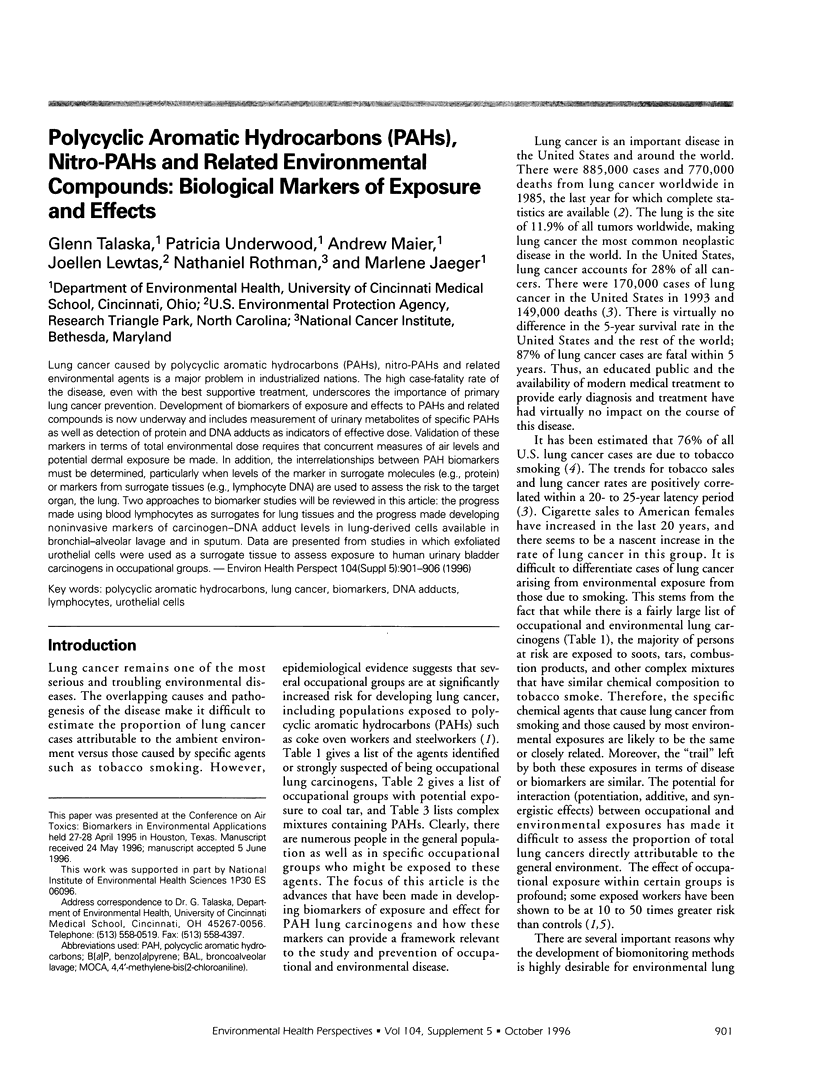
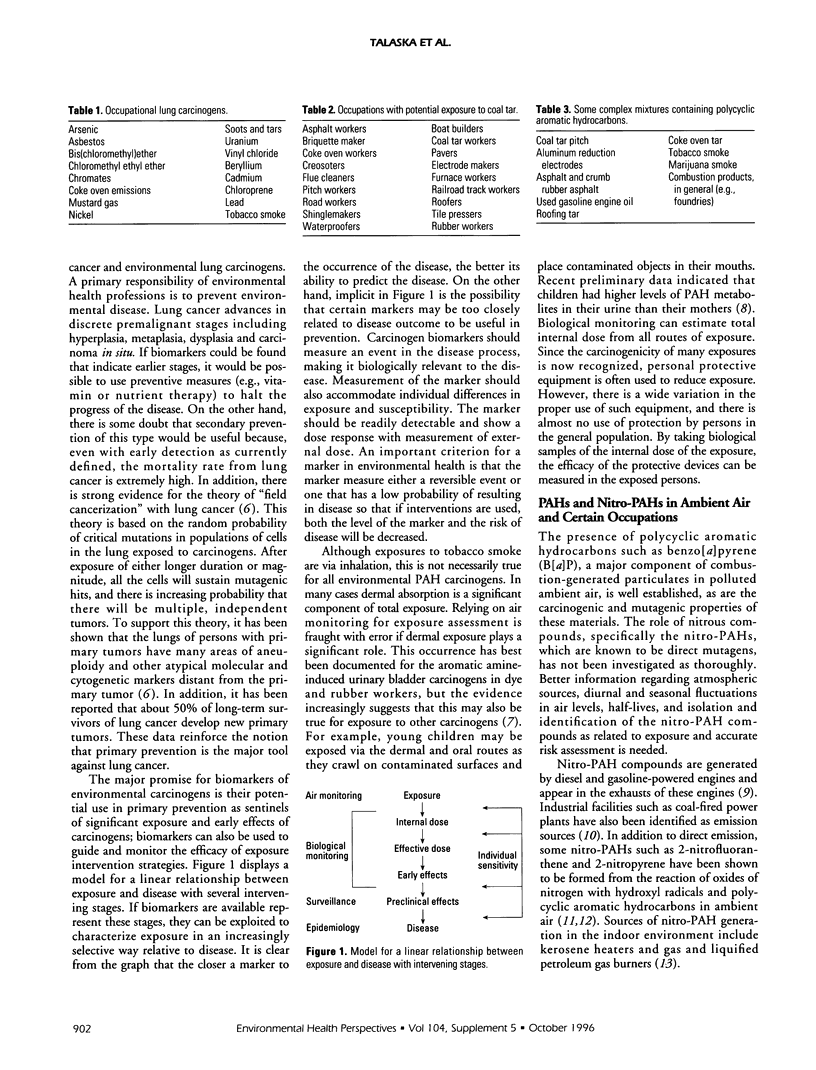
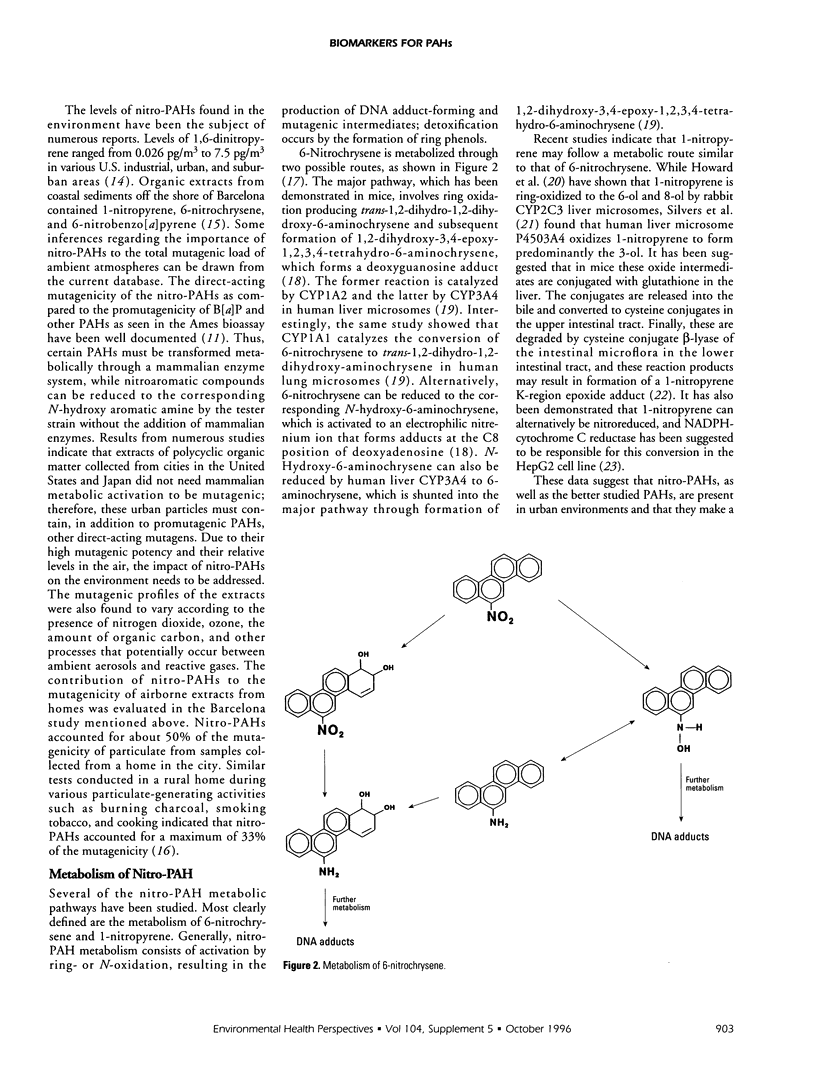
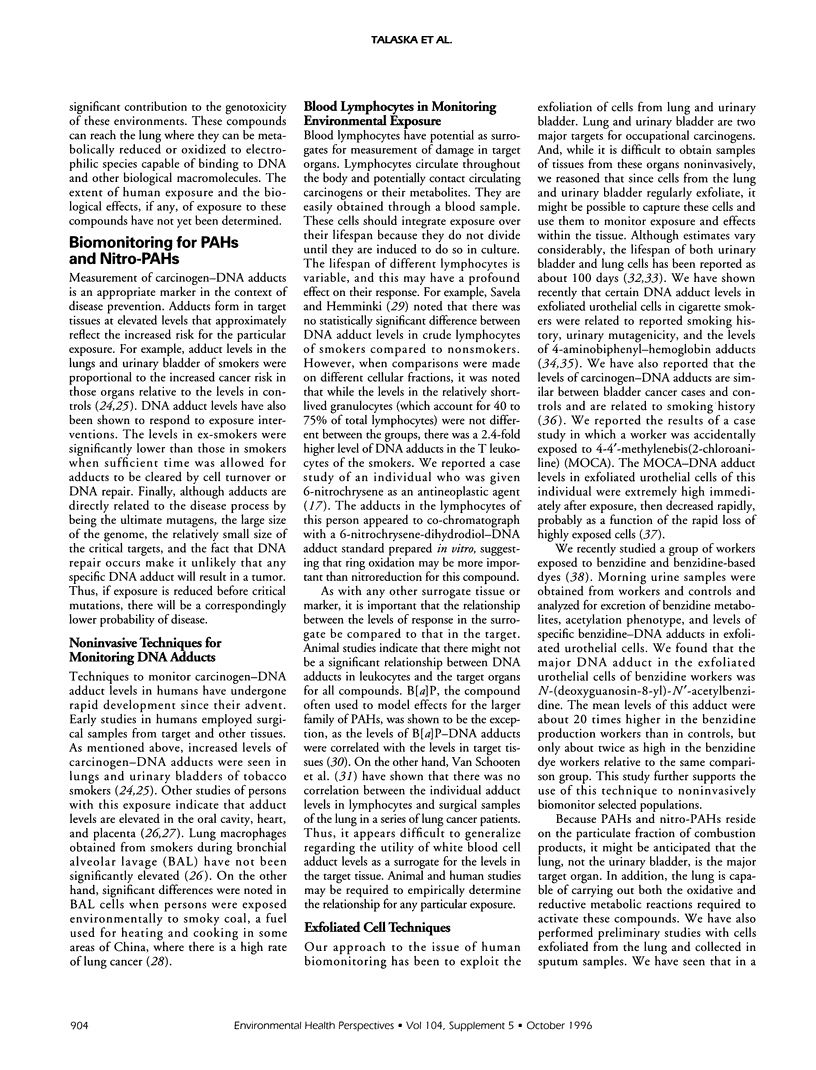
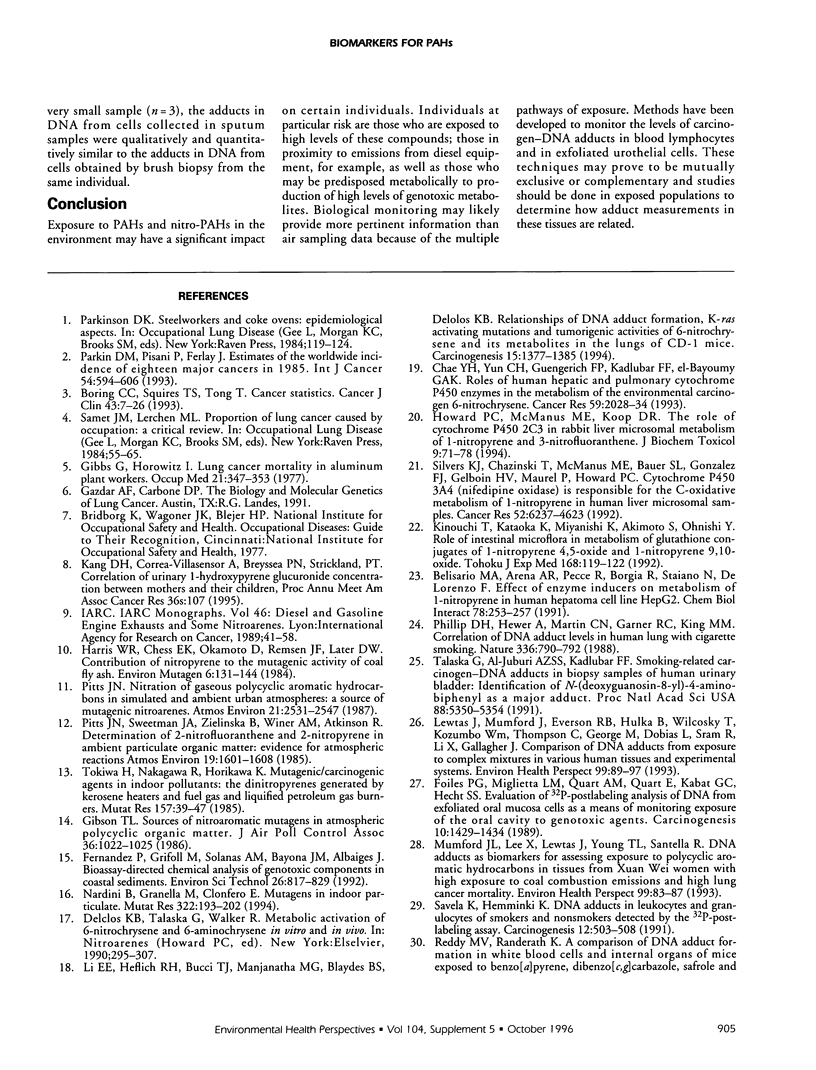
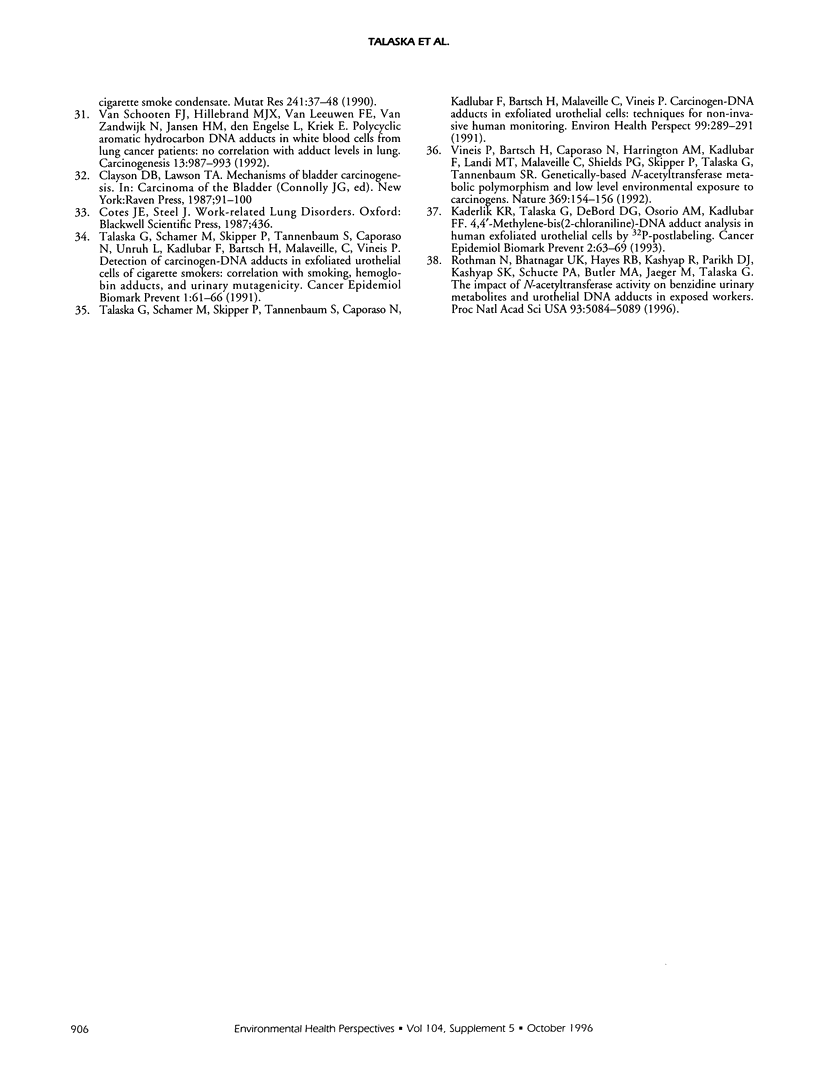
Selected References
These references are in PubMed. This may not be the complete list of references from this article.
- Belisario M. A., Arena A. R., Pecce R., Borgia R., Staiano N., De Lorenzo F. Effect of enzyme inducers on metabolism of 1-nitropyrene in human hepatoma cell line HepG2. Chem Biol Interact. 1991;78(3):253–268. doi: 10.1016/0009-2797(91)90057-e. [DOI] [PubMed] [Google Scholar]
- Boring C. C., Squires T. S., Tong T. Cancer statistics, 1993. CA Cancer J Clin. 1993 Jan-Feb;43(1):7–26. doi: 10.3322/canjclin.43.1.7. [DOI] [PubMed] [Google Scholar]
- Foiles P. G., Miglietta L. M., Quart A. M., Quart E., Kabat G. C., Hecht S. S. Evaluation of 32P-postlabeling analysis of DNA from exfoliated oral mucosa cells as a means of monitoring exposure of the oral cavity to genotoxic agents. Carcinogenesis. 1989 Aug;10(8):1429–1434. doi: 10.1093/carcin/10.8.1429. [DOI] [PubMed] [Google Scholar]
- Gibbs G. W., Horowitz I. Lung cancer mortality in aluminum reduction plant workers. J Occup Med. 1979 May;21(5):347–353. [PubMed] [Google Scholar]
- Gibson T. L. Sources of nitroaromatic mutagens in atmospheric polycyclic organic matter. J Air Pollut Control Assoc. 1986 Sep;36(9):1022–1025. doi: 10.1080/00022470.1986.10466141. [DOI] [PubMed] [Google Scholar]
- Harris W. R., Chess E. K., Okamoto D., Remsen J. F., Later D. W. Contribution of nitropyrene to the mutagenic activity of coal fly ash. Environ Mutagen. 1984;6(2):131–144. doi: 10.1002/em.2860060204. [DOI] [PubMed] [Google Scholar]
- Howard P. C., McManus M. E., Koop D. R. The role of cytochrome P450 2C3 in rabbit liver microsomal metabolism of 1-nitropyrene and 3-nitrofluoranthene. J Biochem Toxicol. 1994 Apr;9(2):71–78. doi: 10.1002/jbt.2570090204. [DOI] [PubMed] [Google Scholar]
- Kaderlik K. R., Talaska G., DeBord D. G., Osorio A. M., Kadlubar F. F. 4,4'-Methylene-bis(2-chloroaniline)-DNA adduct analysis in human exfoliated urothelial cells by 32P-postlabeling. Cancer Epidemiol Biomarkers Prev. 1993 Jan-Feb;2(1):63–69. [PubMed] [Google Scholar]
- Kinouchi T., Kataoka K., Miyanishi K., Akimoto S., Ohnishi Y. Role of intestinal microflora in metabolism of glutathione conjugates of 1-nitropyrene 4,5-oxide and 1-nitropyrene 9,10-oxide. Tohoku J Exp Med. 1992 Oct;168(2):119–122. doi: 10.1620/tjem.168.119. [DOI] [PubMed] [Google Scholar]
- Lewtas J., Mumford J., Everson R. B., Hulka B., Wilcosky T., Kozumbo W., Thompson C., George M., Dobiás L., Srám R. Comparison of DNA adducts from exposure to complex mixtures in various human tissues and experimental systems. Environ Health Perspect. 1993 Mar;99:89–97. doi: 10.1289/ehp.939989. [DOI] [PMC free article] [PubMed] [Google Scholar]
- Li E. E., Heflich R. H., Bucci T. J., Manjanatha M. G., Blaydes B. S., Delclos K. B. Relationships of DNA adduct formation, K-ras activating mutations and tumorigenic activities of 6-nitrochrysene and its metabolites in the lungs of CD-1 mice. Carcinogenesis. 1994 Jul;15(7):1377–1385. doi: 10.1093/carcin/15.7.1377. [DOI] [PubMed] [Google Scholar]
- Mumford J. L., Lee X., Lewtas J., Young T. L., Santella R. M. DNA adducts as biomarkers for assessing exposure to polycyclic aromatic hydrocarbons in tissues from Xuan Wei women with high exposure to coal combustion emissions and high lung cancer mortality. Environ Health Perspect. 1993 Mar;99:83–87. doi: 10.1289/ehp.939983. [DOI] [PMC free article] [PubMed] [Google Scholar]
- Nardini B., Granella M., Clonfero E. Mutagens in indoor air particulate. Mutat Res. 1994 Sep;322(3):193–202. doi: 10.1016/0165-1218(94)90006-x. [DOI] [PubMed] [Google Scholar]
- Parkin D. M., Pisani P., Ferlay J. Estimates of the worldwide incidence of eighteen major cancers in 1985. Int J Cancer. 1993 Jun 19;54(4):594–606. doi: 10.1002/ijc.2910540413. [DOI] [PubMed] [Google Scholar]
- Phillips D. H., Hewer A., Martin C. N., Garner R. C., King M. M. Correlation of DNA adduct levels in human lung with cigarette smoking. Nature. 1988 Dec 22;336(6201):790–792. doi: 10.1038/336790a0. [DOI] [PubMed] [Google Scholar]
- Rothman N., Bhatnagar V. K., Hayes R. B., Zenser T. V., Kashyap S. K., Butler M. A., Bell D. A., Lakshmi V., Jaeger M., Kashyap R. The impact of interindividual variation in NAT2 activity on benzidine urinary metabolites and urothelial DNA adducts in exposed workers. Proc Natl Acad Sci U S A. 1996 May 14;93(10):5084–5089. doi: 10.1073/pnas.93.10.5084. [DOI] [PMC free article] [PubMed] [Google Scholar]
- Savela K., Hemminki K. DNA adducts in lymphocytes and granulocytes of smokers and nonsmokers detected by the 32P-postlabelling assay. Carcinogenesis. 1991 Mar;12(3):503–508. doi: 10.1093/carcin/12.3.503. [DOI] [PubMed] [Google Scholar]
- Silvers K. J., Chazinski T., McManus M. E., Bauer S. L., Gonzalez F. J., Gelboin H. V., Maurel P., Howard P. C. Cytochrome P-450 3A4 (nifedipine oxidase) is responsible for the C-oxidative metabolism of 1-nitropyrene in human liver microsomal samples. Cancer Res. 1992 Nov 15;52(22):6237–6243. [PubMed] [Google Scholar]
- Talaska G., Schamer M., Skipper P., Tannenbaum S., Caporaso N., Kadlubar F., Bartsch H., Vineis P. Carcinogen-DNA adducts in exfoliated urothelial cells: techniques for noninvasive human monitoring. Environ Health Perspect. 1993 Mar;99:289–291. doi: 10.1289/ehp.9399289. [DOI] [PMC free article] [PubMed] [Google Scholar]
- Talaska G., Schamer M., Skipper P., Tannenbaum S., Caporaso N., Unruh L., Kadlubar F. F., Bartsch H., Malaveille C., Vineis P. Detection of carcinogen-DNA adducts in exfoliated urothelial cells of cigarette smokers: association with smoking, hemoglobin adducts, and urinary mutagenicity. Cancer Epidemiol Biomarkers Prev. 1991 Nov-Dec;1(1):61–66. [PubMed] [Google Scholar]
- Talaska G., al-Juburi A. Z., Kadlubar F. F. Smoking related carcinogen-DNA adducts in biopsy samples of human urinary bladder: identification of N-(deoxyguanosin-8-yl)-4-aminobiphenyl as a major adduct. Proc Natl Acad Sci U S A. 1991 Jun 15;88(12):5350–5354. doi: 10.1073/pnas.88.12.5350. [DOI] [PMC free article] [PubMed] [Google Scholar]
- Tokiwa H., Nakagawa R., Horikawa K. Mutagenic/carcinogenic agents in indoor pollutants; the dinitropyrenes generated by kerosene heaters and fuel gas and liquefied petroleum gas burners. Mutat Res. 1985 Jul;157(1):39–47. doi: 10.1016/0165-1218(85)90047-3. [DOI] [PubMed] [Google Scholar]
- Vineis P., Bartsch H., Caporaso N., Harrington A. M., Kadlubar F. F., Landi M. T., Malaveille C., Shields P. G., Skipper P., Talaska G. Genetically based N-acetyltransferase metabolic polymorphism and low-level environmental exposure to carcinogens. Nature. 1994 May 12;369(6476):154–156. doi: 10.1038/369154a0. [DOI] [PubMed] [Google Scholar]
- van Schooten F. J., Hillebrand M. J., van Leeuwen F. E., van Zandwijk N., Jansen H. M., den Engelse L., Kriek E. Polycyclic aromatic hydrocarbon--DNA adducts in white blood cells from lung cancer patients: no correlation with adduct levels in lung. Carcinogenesis. 1992 Jun;13(6):987–993. doi: 10.1093/carcin/13.6.987. [DOI] [PubMed] [Google Scholar]


